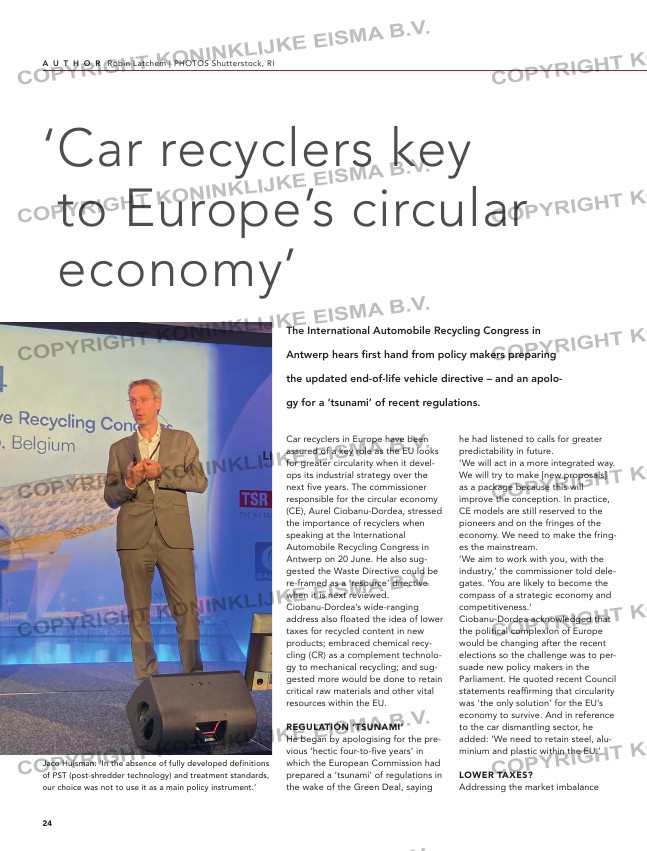Page 24 from: What’s inside issue #4?

24
‘ Car recyclers key
to Europe’s circular
economy’
The International Automobile Recycling Congress in
Antwerp hears first hand from policy makers preparing
the updated end-of-life vehicle directive – and an apolo-
gy for a ‘tsunami’ of recent regulations.
Car recyclers in Europe have been
assured of a key role as the EU looks
for greater circularity when it devel-
ops its industrial strategy over the
next five years. The commissioner
responsible for the circular economy
(CE), Aurel Ciobanu-Dordea, stressed
the importance of recyclers when
speaking at the International
Automobile Recycling Congress in
Antwerp on 20 June. He also sug-
gested the Waste Directive could be
re-framed as a ‘resource’ directive
when it is next reviewed.
Ciobanu-Dordea’s wide-ranging
address also floated the idea of lower
taxes for recycled content in new
products; embraced chemical recy-
cling (CR) as a complement technolo-
gy to mechanical recycling; and sug-
gested more would be done to retain
critical raw materials and other vital
resources within the EU.
REGULATION ‘TSUNAMI’
He began by apologising for the pre-
vious ‘hectic four-to-five years’ in
which the European Commission had
prepared a ‘tsunami’ of regulations in
the wake of the Green Deal, saying
he had listened to calls for greater
predictability in future.
‘We will act in a more integrated way.
We will try to make [new proposals]
as a package because this will
improve the conception. In practice,
CE models are still reserved to the
pioneers and on the fringes of the
economy. We need to make the fring-
es the mainstream.
‘We aim to work with you, with the
industry,’ the commissioner told dele-
gates. ‘You are likely to become the
compass of a strategic economy and
competitiveness.’
Ciobanu-Dordea acknowledged that
the political complexion of Europe
would be changing after the recent
elections so the challenge was to per-
suade new policy makers in the
Parliament. He quoted recent Council
statements reaffirming that circularity
was ‘the only solution’ for the EU’s
economy to survive. And in reference
to the car dismantling sector, he
added: ‘We need to retain steel, alu-
minium and plastic within the EU.’
LOWER TAXES?
Addressing the market imbalance
between virgin materials and recy-
clates, the commissioner acknowl-
edged it was not politically appealing
to ‘tax virgin more’. But he suggest-
ed, alongside other measures to
make recyclates more attractive, they
could be taxed less. During questions
afterwards, Ciobanu-Dordea said
lower taxes for recyclates was a ‘topic
for active consideration; we need to
reflect on this’.
As for converting the Waste Directive
to one about resources, he thought it
was ‘a tall order – but we hear the
call’.
Turning specifically to the forthcom-
ing ELV Directive for end-of-life vehi-
cles, the commissioner hoped it
would enter into force by July 2025.
He praised the recent work of the
Belgian presidency in driving it for-
ward and believed the subsequent
Hungarian and Polish presidencies
would maintain progress. But cau-
tioned this would need the support of
the automotive sector and the OEMs
in particular.
‘Some of the big beasts of the car
industry have engaged with us. But
not everyone has and some have lob-
bied against us. We call on all manu-
facturers in Europe to … find the
median line that works for every-
body.’
CR ‘IMPORTANT’
Ciobanu-Dordea thought that the
proposed eco-design directive would
‘dovetail’ into the ELV directive in
terms of the sustainability of steel,
aluminium and tyres. Meanwhile, he
expected the Single Use directive for
plastics to recognise the use of CR for
plastics and packaging.
‘Chemical recycling will play an
important role as plastic exports [from
Europe] are removed,’ he said, while
insisting that mechanical recycling
would not be ‘economically intimidat-
ed’ by CR. He thought CR would be
relevant for tyre recycling.
The commissioner concluded: ‘We
plan to stay engaged with you –
together with the automotive indus-
Jaco Huisman: ‘In the absence of fully developed definitions
of PST (post-shredder technology) and treatment standards,
our choice was not to use it as a main policy instrument.’
A U T H O R Robin Latchem | PHOTOS Shutterstock, RI
24-25-26_iarcpart1.indd 24 03-07-2024 10:08



